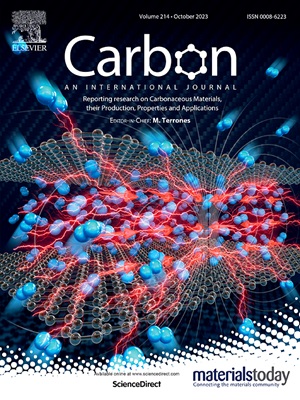Stress-induced volume expansion suppression in silicon films on carbon nanotubes grown on carbon fibers for ultrahigh-stability flexible lithium-ion battery anodes
IF 10.5
2区 材料科学
Q1 CHEMISTRY, PHYSICAL
引用次数: 0
Abstract
Herein, a flexible, binder-free carbon-fiber cloth supported silicon@nitrogen-doped carbon nanotubes (Si@NCNT/CC) anode is developed using chemical-vapor-deposition (CVD) and radio-frequency plasma magnetron sputtering (RF-PMS) techniques. The three-dimensional conductive network skeleton of NCNT/CC meticulously designed by the CVD method not only facilitates the release of volumetric stress of Si during cycling but also improves the overall electronic conductivity of the composite anode. Combined with the single-atom Si deposition via RF-PMS technology, it enables the precise design of amorphous Si films that fit the dimensions of the NCNT skeleton. This design notably boosts lithium-ion diffusion and accelerates reaction kinetics, while simultaneously demonstrating superb mechanical flexibility. When employed as an anode in flexible lithium-ion batteries (FLIBs), it demonstrates a discharge capacity of 1166.1 mAh g−1 at 0.5 A g−1, retaining 82.4 % of its capacity after 200 cycles. Even at 5 A g−1, it still achieves a discharge capacity of 338.1 mAh g−1 and maintains 81 % capacity after 500 cycles. The full cells are assembled with Si@NCNT/CC as the anode, while the cathodes are made of LiNi0.8Co0.1Mn0.1O2 and LiFePO4 coated on CC, respectively, both exhibiting excellent cycling and rate performance. Practical pouch cell tests confirm the anode's flexibility and stable electrochemical performance under mechanical deformation.

求助全文
约1分钟内获得全文
求助全文
来源期刊

Carbon
工程技术-材料科学:综合
CiteScore
20.80
自引率
7.30%
发文量
0
审稿时长
23 days
期刊介绍:
The journal Carbon is an international multidisciplinary forum for communicating scientific advances in the field of carbon materials. It reports new findings related to the formation, structure, properties, behaviors, and technological applications of carbons. Carbons are a broad class of ordered or disordered solid phases composed primarily of elemental carbon, including but not limited to carbon black, carbon fibers and filaments, carbon nanotubes, diamond and diamond-like carbon, fullerenes, glassy carbon, graphite, graphene, graphene-oxide, porous carbons, pyrolytic carbon, and other sp2 and non-sp2 hybridized carbon systems. Carbon is the companion title to the open access journal Carbon Trends. Relevant application areas for carbon materials include biology and medicine, catalysis, electronic, optoelectronic, spintronic, high-frequency, and photonic devices, energy storage and conversion systems, environmental applications and water treatment, smart materials and systems, and structural and thermal applications.
 求助内容:
求助内容: 应助结果提醒方式:
应助结果提醒方式:


